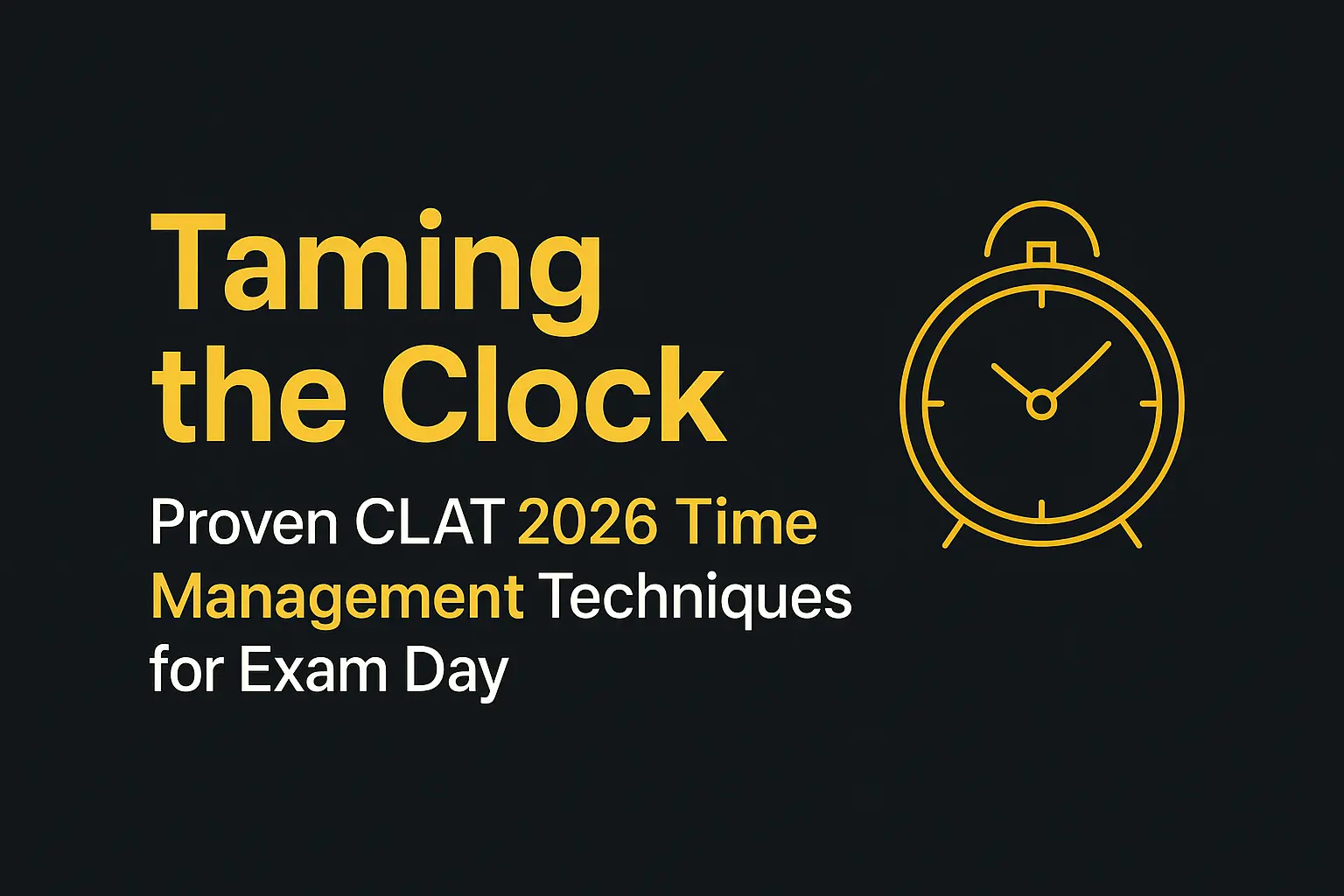
1. Why time management is the real cut-off
CLAT 2026 Time Management – Two hours. One hundred and twenty minute passage-heavy MCQs spread across five sections. That’s the entire playground you get on 1 December 2025 when the Consortium fires the starting gun for CLAT 2026 UG. The exam pattern hasn’t changed since last year, so you’re still looking at the mix below:
(Bookmark this guide, share it with your study group, and come back whenever the clock feels like your enemy.)
| Section | Questions | Weight (%) | Our “ideal” minutes |
|---|---|---|---|
| English Language | 22–26 | ~20 % | 20 |
| Current Affairs & GK | 28–32 | ~25 % | 10–12 |
| Legal Reasoning | 28–32 | ~25 % | 30–35 |
| Logical Reasoning | 22–26 | ~20 % | 25–28 |
| Quantitative Techniques | 10–14 | ~10 % | 15 |
| Flex buffer / review | — | — | 8–10 |
| Total | 120 | 100 % | 120 min |
Think of those minute-allocations as lane ropes in a swimming pool: you can drift a little, but slam into the rope and you’ll lose rhythm—and marks.
2. Reverse-engineer exam day (the 72-hour drill)
“Toppers don’t begin with the syllabus; they begin with the finish line.” — TOI Education Times of India
72 hours out
- Dry-run #1: Attempt a full mock in the afternoon slot (2–4 p.m.) to sync your body clock.
- Time audit: Note over-spent minutes per section; patch the leaks.
24 hours out
- Dry-run #2: One more mock, but this time practise the skip-and-park rule (see §4).
- Pack checklist: Admit card, two black pens, ID, analogue watch, sugar snack.
Morning of exam
- Energy map: Light carbs + protein breakfast at least 3 hours before the bell.
- Digital detox: Phone in flight mode until after the paper. You don’t need last-minute reels messing with cortisol.
Stick that timeline on your wall—yes, a physical A4 sheet. Visual cues beat mental notes every single time.
3. The five golden laws of CLAT 2026 Time Management
- Read the questions first, passage second.
- 50-10 cadence while practising. Study 50 minutes, breathe 10. This trains your neural stamina for a 2-hour sprint. Times of India
- Skip-flag-return. Every tough nut costs not only marks but minutes. Flag it; revisit if the buffer remains.
- No sectional ego. There’s no sectional cut-off. Dump a Quant outlier if it eats more than 90 seconds.
- Post-mortem every mock. Track why you overshot time: reading speed, over-analysis, or sheer indecision? Tools such as our CLAT Mock Test Analysis guide walk you through that autopsy.
4. The 120-minute playbook
| Clock | What you’re doing | Micro-goal |
|---|---|---|
| 0:00 – 0:02 | Skim the whole paper | Mark super-easy questions with a ✔ |
| 0:03 – 0:23 | English Language | 22–26 Qs, aim 85 %+ accuracy |
| 0:23 – 0:33 | GK & Current Affairs | Blitz 30 Qs in one pass |
| 0:33 – 1:08 | Legal Reasoning | Read passage once → answer → move on |
| 1:08 – 1:33 | Logical Reasoning | Prioritise short-passage sets |
| 1:33 – 1:48 | Quant Techniques | 10–14 Qs, use approximation tricks |
| 1:48 – 2:00 | Buffer & review | Re-visit flagged items, fill OMR neatly |
Notice how buffers sit at both ends of the schedule—the first two minutes to breathe and the last twelve to rescue marks.
5. Section-wise ninja tricks
English
Skim > scan > solve. Use keywords in the questions to predict what the passage will test. That alone cuts reading time by ~25 %.
GK
Treat it like rapid-fire. If you don’t know in 5 seconds, bubble B isn’t a strategy. Pass and return.
Legal Reasoning
Structure: fact → principle → application. Read the principle twice before the fact pattern; speeds up analysis. Toprankers’ toppers vouch for 30-35 min as the sweet spot. Toprankers
Logical Reasoning
Chunk the passage: main idea, tone, inference. Write one-word notes (MI/T/INF) in the margin as anchors.
Quant
Round off whenever decimals appear—CLAT never tests calculator precision, only number sense.
6. Tools & internal resources you’ll love
- CLAT Legal Reasoning syllabus decoded – brush up passages quickly.
- CLAT Coaching 2025 programme – sign-up gives you the Rank Booster mocks (built with the minute allocations above).
- Rank & College Predictors will go live the week the result drops—watch elearning.learncrew.org for the button in your dashboard.
7. A quick pep talk from Ananya (AIR 132, CLAT 2025)
“My mantra was ‘timer on, mind on.’ I set a phone timer for each section during every study session. When the beep sounded, pens down—no exceptions. By the fifteenth mock I could feel when 25 minutes had passed without looking. On D-day, the bell felt like just another practice session.”
Borrow her mindset: chase rhythm, not the scoreboard.
8. FAQs for CLAT 2026 Time Management
Q 1. Is scanning all 120 questions first worth the time?
Yes—two minutes of overview can save five minutes of dithering later.
Q 2. Should I attempt Quant last?
If you’re Quant-averse, yes. But strong number-crunchers may swap GK and Quant to kick off with confidence.
Q 3. How many mocks should I finish before December?
Bare minimum: 30 full-length papers plus sectional drills. Each mock refines your CLAT 2026 Time Management muscle memory.
9. Final checklist (print & paste above your study desk)
- Internalise section-wise timers.
- Practise the 50-10 cadence.
- Analyse every mock with a time-spent matrix.
- Simulate exam slot at least twice.
- Sleep 7 hours the night before.
Do these, and the clock becomes a teammate—not a tyrant.
Master CLAT 2026 Time Management.
Sources
- Careers360, “CLAT Exam Pattern 2026 – Paper Format, Weightage, Marks Distribution” Careers360 Law
- Toprankers, “CLAT Time Management Tips & Tricks 2026 by Exam Toppers” Toprankers
- Times of India, “10 time management techniques that can define success in competitive examinations,” 21 May 2025 Times of India





